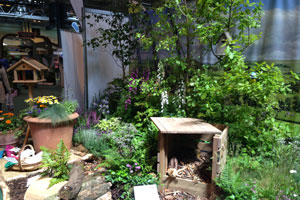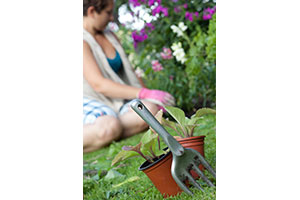Release the natural potential of your garden
 Visitors to this year’s BBC Gardeners’ World Live show at Birmingham NEC (12th to 15th June) are being asked to consider the role their garden plays in their lives and release its potential for welcoming wildlife.
Visitors to this year’s BBC Gardeners’ World Live show at Birmingham NEC (12th to 15th June) are being asked to consider the role their garden plays in their lives and release its potential for welcoming wildlife.
Large or small, ledge or yard, gardens are part of a wider network of spaces for nature linking urban green areas such as parks and gardens with nature reserves and the countryside.
With an estimated 16 million in the UK, the way gardens are cared for can make a big difference to wildlife and to our quality of life. The Wildlife Trusts are encouraging visitors to this year’s show to see their stand at GFW2 for inspiration and then go wild in their gardens!
Whatever our gardens may be to us, they are wildlife havens waiting to happen and no matter where we live we are all able to give wildlife a hand. Visitors to the Wildlife Trusts’ stand will be able to consider the transformations they might make, which could also help to make them happier and healthier.
Perhaps your hobby is spending precious free time in your shed – build a log-pile which will be home and food for various beetle grubs and an army of other mini-beasts. If your garden is your sanctuary plant a night-scented garden and enjoy the fruits of your labour. If you harvest from your garden and it is your grocer then remember most garden produce needs pollinators so consider a garden rich in nectar. Build a bee hotel for mason bees and companion planting to help deal with pests which might target your prize produce. If your garden is your playground then wildlife gardening offers chances of learning about a range of wild creatures in a safe yet exciting environment.
Paul Wilkinson, the Wildlife Trusts’ Head of Living Landscape says: “Simple actions should see you rewarded with visits from some wonderful species, and all in the knowledge you are making a positive contribution to wildlife and the environment.
“Hedgehogs, sparrows, song thrushes and stag beetles are all declining species in the UK, but if we manage our gardens to benefit wildlife, these creatures and many more will find refuge. It’s not hard to help.”
 Professor Chris Bains, The Wildlife Trusts’ Vice President and a wildlife gardening guru stresses that our gardens provide many of us with our daily dose of nature at close quarters, offering the perfect natural relief from the hum-drum pressures of work, travel and shopping: “Nest boxes, bird feeders, nectar plants, fruiting shrubs, wall climbers, ponds and drinking fountains improve the life-chances for birds and butterflies, hedgehogs, frogs and many other garden creatures, and as the garden habitat improves for them, it’s bound to bring more enjoyment for people, too,” he says. Chris made a wildlife garden at the very first Gardeners’ World Live show way back in 1992 and remembers that in those days it was a bit of a revolution, however, over the past 22 years gardening with nature has become mainstream and it brings millions of gardeners a great deal of pleasure and a real sense of achievement.
Professor Chris Bains, The Wildlife Trusts’ Vice President and a wildlife gardening guru stresses that our gardens provide many of us with our daily dose of nature at close quarters, offering the perfect natural relief from the hum-drum pressures of work, travel and shopping: “Nest boxes, bird feeders, nectar plants, fruiting shrubs, wall climbers, ponds and drinking fountains improve the life-chances for birds and butterflies, hedgehogs, frogs and many other garden creatures, and as the garden habitat improves for them, it’s bound to bring more enjoyment for people, too,” he says. Chris made a wildlife garden at the very first Gardeners’ World Live show way back in 1992 and remembers that in those days it was a bit of a revolution, however, over the past 22 years gardening with nature has become mainstream and it brings millions of gardeners a great deal of pleasure and a real sense of achievement.
“Its not just about doing great things for nature,” Chris adds. “but also about enjoying the wildlife that is already there. Take a moment to listen to garden birdsong, marvel at how insects find our flowers or turn over a few stones to discover what lives beneath them.”
Don’t worry if you cannot get to BBC Gardeners’ World Live this year, you can find out more on line about creating a wildlife garden at:
www.wildlifetrusts.org or at the Wild About Gardens website.
The forthcoming Wildlife Trusts’ Our Garden Wildlife Weekend will be held on 12/13th July and celebrates the UK’s natural treasures in 2014. The Wildlife Trusts’ will be hosting a series of wild weekends to offer endless opportunities to visit, discover and explore.
We have included a tick-list of features (see below) to include, no matter how small or large your patch, to attract more wildlife into your garden.
Photo credits: (1) The Wildlife Trusts”, (2) ©The Wildlife Trusts’, Tom Marshall
ATTRACTING WILDLIFE TO YOUR GARDEN
To attract more wildlife to your garden, and more regularly, there is a tick-list of key features to include, no matter how small or large your patch. The list includes trees, dead wood, water, and a variety of plant shapes and sizes. We may not be able to provide everything on that ideal tick list, but it doesn’t matter too much because, hopefully, other gardens in our neighbourhoods will complement what we do.
Areas of longer grass in the garden can be valuable to a variety of wildlife. They provide a miniature haven for species traditionally reliant on our declining meadow habitat. Tall grasses support delicate wildflower and plant species, shielding them from harsh weather.
Dead wood – a log pile or standing in the ground – in a shady spot will act as a refuge and feeding station for frogs, toads, and hedgehogs. It provides an excellent home for other species too, including the grubs of some species of beetles, which may live there for many years before maturing.
Many minibeasts – whose whole world is in your garden – are beautiful creatures which breathe life into the garden in their own right. But as parts of nature they are also a vital ingredient in the food supply that larger creatures rely on – whether blackbirds, frogs, or hedgehogs. So, if we look after them, it seems to make sense that the rest will almost look after itself.
Six things you can do to nurture nature in your garden:
1. Please the pollinators! Plants such as viper’s bugloss, comfrey and bird’s foot trefoil are beloved by bees.
2. Say goodbye to slug pellets, and say hello to garden-friendly hedgehogs, frogs and birds that will eat slugs and snails for you. An area of long grasses and a pile of logs will give your new friends a refuge too.
3. Install a bird box or a bat box. Or better still, both!
4. Create a pond to make your own mini-wetland: quite apart from the creatures that may come to live in it, others may find it to feed, drink, bathe and breed.
5. Add wildflowers for wildlife: scatter native wildflower seeds for an easy burst of colour and a great way to attract new species to your garden.
6. Start a compost heap. Compost is good for your garden, reduces landfill and makes it easy to dispose of your kitchen and garden waste. But a compost heap will also attract worms, insects, birds and other insect and slug predators such as hedgehogs. You might even find a common newt sheltering there.

